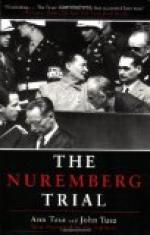|
This section contains 2,419 words (approx. 9 pages at 300 words per page) |

|
Albert Speer was Hitler's chief architect and minister for armaments and war production. In the former position he was tasked with rebuilding Berlin, but his grandiose vision was never realized. He did, however, design the parade grounds, searchlights, and banners used in the Nuremberg party congress of 1934. In 1942, Speer became minister of armaments and munitions and later became responsible for all war production. In this position, he made extensive use of slave laborers taken from concentration camps to produce material for Germany's war effort. A confidant of Hitler for most of the war, Speer lost favor when he refused to carry out the Fuhrer's order to destroy German installations that were about to be captured by the Allies late in the war. Unlike his co-defendants on trial, Speer acknowledged his guilt and this undoubtedly led the justices to give...
|
This section contains 2,419 words (approx. 9 pages at 300 words per page) |

|




